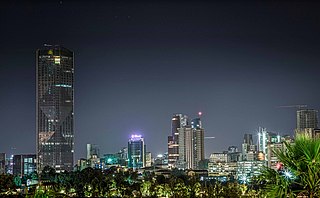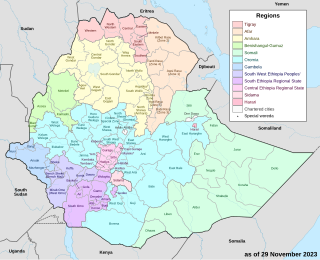
Addis Ababa is the capital and largest city of Ethiopia. In the 2007 census, the city's population was estimated to be 2,739,551 inhabitants. Addis Ababa is a highly developed and important cultural, artistic, financial and administrative center of Ethiopia. It is widely known as one of Africa's major capitals.

Oromia is a regional state in Ethiopia and the homeland of the Oromo people. Under Article 49 of Ethiopian Constitution, the capital of Oromia is Addis Ababa, also called Finfinne. The provision of the article maintains special interest of Oromia by utilizing social services and natural resources of Addis Ababa.
Bonga is a town, woreda and one of the multicapital of the South West Ethiopia Peoples' Region in Ethiopia. Located in the Keffa Zone upon a hill in the upper Barta valley, it has a latitude and longitude of 7°16′N36°14′E with an elevation of 1,714 meters above sea level. Not confused with another town named "Bonga", near Gambela Region.
Metu is a market town and separate woreda in south-western Ethiopia. Located in the Illubabor Zone of the Oromia along the Sor River, this town has a latitude and longitude of 8°18′N35°35′E and an altitude of 1605 meters. Metu was the capital of the former Illubabor Province from 1978 until the adoption of the new constitution in 1995.
Addis Alem is a town in central Ethiopia. Located in the West Shewa Zone of the Oromia Region, west of Addis Ababa, this town has a latitude and longitude of 9°2′N38°24′E with an elevation of about 2360 meters above sea level.

Ambo is a town in west-central Ethiopia. Located in the West Shewa Zone of Oromia Region, west of Addis Ababa, it is the capital city of West Shewa zone. This town has a latitude and longitude of 8°59′N37°51′E and an elevation of 2,101 meters.

Dembidollo, also spelled Dembi Dolo, is a market town and separate woreda in south-western Ethiopia. It is the capital of Kelam Welega Zone of the Oromia Region. This town, which is at an elevation of between 1,701 m (5,581 ft) and 1,827 m (5,994 ft) above sea level, was originally known as Sayo.
Erer is a woreda in Somali Region, Ethiopia. Part of the Shinile Zone, Erer is bordered on the south by Dire Dawa and Oromia Region, on the southwest by Afdem, on the northwest by the Afar Region, and on the east by Shinile.
Cheliya is one of the Aanaas in the Oromia of Ethiopia. Part of the West Shewa Zone, Cheliya is bordered on the south by Nono and Dano, on the southwest by the Gibe River which separates it from the Jimma Zone, on the west by Bako Tibe, on the northwest by the Guder River which separates it from the Horo Gudru Welega Zone, on the north by Ginde Beret, on the northeast by Jeldu, on the east by Ambo, and on the southeast by Tikur. The administrative center of this Aanaa is Gedo; other towns in Cheliya include Babiche, Ejaji, and Hamus Gebeya. Midakegn woreda was separated form Cheliya.
Bako Tibe is one of the Aanaas, or districts, in the Oromia region of Ethiopia. Part of the West Shewa Zone, Bako Tibe is bordered on the south and west by the East Welega Zone, on the north by Horo Gudru Welega Zone, and on the east by Cheliya. The administrative center of this woreda is Bako; other towns in Bako Tibe include Tibe and Shoboka.
Yubdo or Jubdo is a woreda in Oromia Region, Ethiopia. Part of the West Welega Zone, Yubdo is bordered on the south by Nole Kaba, on the west by Kelem Welega Zone, on the northwest by Ayra Guliso, on the northeast by Lalo Asabi, on the east by Gimbi, and on the southeast by Haru. The administrative center of this woreda is Yubdo; other towns in Yubdo include Ganji.
Sibuu Siree is one of woredas in the Oromia Region of Ethiopia. Part of the Misraq (East) Welega Zone, Sibu Sire is bordered on the south by Wama Bonaya, on the west by Guto Wayu, and on the north and east by Bila Seyo. The administrative center of this woreda is Sire.
Dire is one of the Aanaas in the Oromia of Ethiopia. Miyu was separated from Dire woreda. Located in the southern part of the Borena Zone, Dire is bordered on the south by Kenya, on the west by Teltele, on the north by Yabelo, on the northeast by Arero, and on the east by Moyale. Towns in Dire include Mega and Dubuluk.
Holeta is a town in the special zone of Oromia Region, Ethiopia. It has a latitude and longitude of 9°3′N38°30′E and an altitude of 2391 meters above sea level.
Gimbi (ጊምቢ) is a town in western Oromia Region, Ethiopia. Located in the West Welega Zone, it has a latitude and longitude of 9°10′N35°50′E with an elevation between 1845 and 1930 meters above sea level. It is the administrative center of Gimbi woreda.

Mojo is a town in central Ethiopia, named after the nearby Modjo River. Located in the East Shewa Zone of the Oromia Region, it has a latitude and longitude of 8°39′N39°5′E with an elevation between 1788 and 1825 meters above sea level. It is the administrative center of Lome district.

Kellem Wollega is one of the zones of the Oromia Region in Ethiopia. This zone is named after the former province of Wollega, whose western part lay in the area Kellem Wollega now occupies. Kellem Wollega was formed of woredas which included to West Wollega Zone.

The Oromo Liberation Army is an armed opposition group active in the Oromia Region of Ethiopia. The OLA consist primarily of former armed members of the pre-peace deal Oromo Liberation Front (OLF) who refused to disarm out of skepticism of the peace deal, and former youth protestors who grew disillusioned with nonviolent resistance.
Baro Tumsa (1938–1978) was a pharmacist, lawyer and Oromo nationalist and political activist in Ethiopia. He was the younger brother of Reverend Gudina Tumsa and later joined the Oromo Liberation Front after being expelled from Finfinne by The Dergue.

The OLA insurgency is an armed conflict between the Oromo Liberation Army (OLA), which split from the Oromo Liberation Front (OLF) in 2018, and the Ethiopian government, continuing in the context of the long-term Oromo conflict, typically dated to have started with the formation of the Oromo Liberation Front in 1973.












